As the 2020 summer drew to a close, I got the last bits of needed work done on the Stray Goat, or so I thought, so I decided it was time to do a little "yard sailing" and check out the rig before my first launch. Here's how it looked when I raised the sail in my yard.
I had never sailed a boat with a lug rig, so looked for lug rig guidance at Goat Island Skiff designer Michael Storer's website. Shown at left is how I rigged the "bleater" using what Storer described as the "strong" method.
As mentioned on the previous page in this series, the builder of Julie B had put the stainless D-ring for the downhaul aft of the mast. This led to a crack in the mast partner, which I repaired, and led to a comment on Facebook from Michael Storer that the D-ring should be beside the mast, not behind it. I moved it. The builder had opted for the "vang-haul" setup described on the Storer web page linked above. At right is how it looked when I first raised the sail.
Michael Storer said that the downhaul/vang-haul tension is critical for a lug sail performance so I think I will replace the horn cleat with a cam cleat for easier adjustment. At left is how the rig looks with the sail fully eased out. Note the shorter tag end on the vang-haul line, as I had to ease it out some to let the sail all the way out. The block is rubbing against the mast, so maybe I'll put a piece of leather there or wrap it in rope to protect it.
With the sail flipped to the other side, there's a whole lot of slack in the vang-haul line.
I rigged up the mainsheet traveler the same way the builder had left it.
And tied the mainsheet ratchet block line more or less the way I remembered finding it.
Satisfied that the boat was usable, I headed down to the ramp at the Port Charlotte Beach Complex for my first sail. The Goat looks great waiting at the dock, but the image at left shows the first problem I encountered: The daggerboard bound up and I could not get it to go all the way down. I decided it was better than nothing and I'd take the boat out anyway. My friend Dennis was coming over to sail with me, so my plan was just to sail around in the small basin beside the boat ramp until he showed up.
I found that the boat had a bit of lee helm and didn't do too well tacking upwind. I headed downwind into the center of the basin and was just drifting along in the light breeze when I saw the ripples from a gust of wind coming at me across the water. As it hit and the boat accelerated, I remember thinking this was going to be fun and then I remember diving for the newly-uphill side of the boat before falling into the water as it capsized toward me. Reversed airflow at the top of the sail had created a powerful sideways lifting force that just drove the top of the mast into the water.
I righted the boat and got back in but it was very unstable, being half full of water. Before capsizing again, I noticed lots of bubbles coming out of the aft buoyancy compartment. I decided to abort and put the boat back on the trailer. I released the halyard and tied the sail into the boat before righting it again and getting back in to paddle over to the dock. Dennis showed up about that time and he got a 1500 gph bilge pump and an 18 volt drill battery out of his truck. Good thing too because bailing it all out with my little bailer was going to take half an hour at least. Rowed over to the ramp and put it back on the trailer. Rowing upwind was difficult, probably mostly because I don't row and the oars are not great.
When I got home I found that the forward buoyancy compartment also had water inside. Not sure exactly where it's leaking but it's around the bulkhead just forward of the mast so difficult to access. AFter all the work of restoring the boat, I was not happy with the prospect of more work before I could sail the boat again. I also figured that by the time I finished the necessary work and got back to sailing, it would not be long at all before the seasonal decline in water temperatures would make capsizing no fun at all. I don't like water below 80 degrees. I decided to buy the boat a cover and park it under my house until the harbor got warm again.
Now the water is warm again and I'm back in the mood to work on the Stray Goat. I plan to reshape the daggerboard trunk so that the board goes all the way down, do something to protect the mast, yard, and boom where they wear against each other, rework the trailer bunks to better support the boat, and varnish the tiller and rudder cassette.
I'm thinking of installing deck plates atop the bow and stern buoyancy compartments to allow me to re-seal the bulkheads from the inside. The bow compartment's bulkhead edges are not easy to access so I just think doing it from above through a deck plate will be easier.
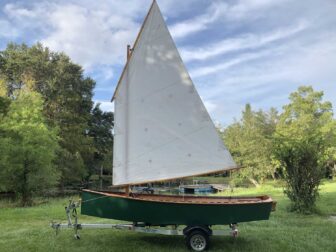
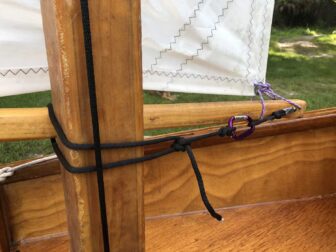
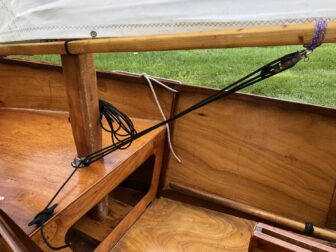
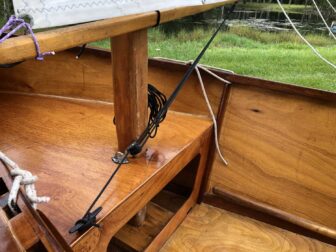
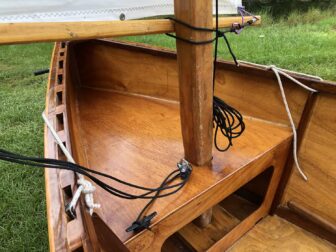
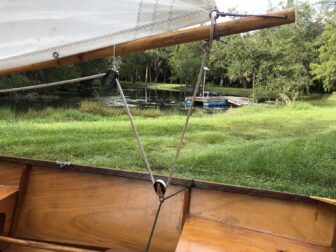
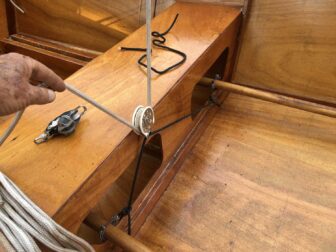
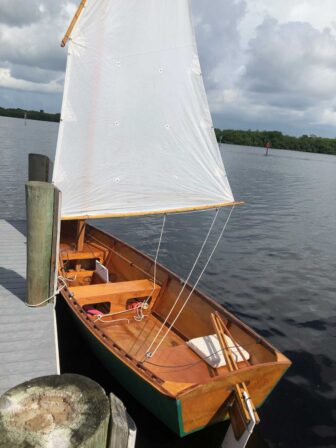
Leave a Reply
You must be logged in to post a comment.